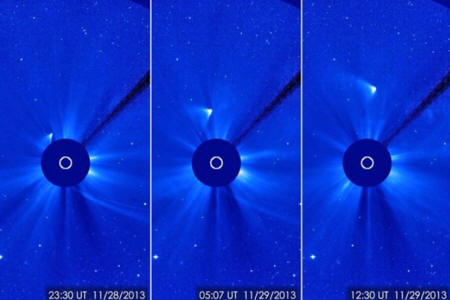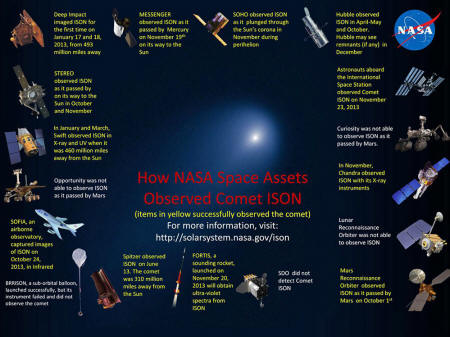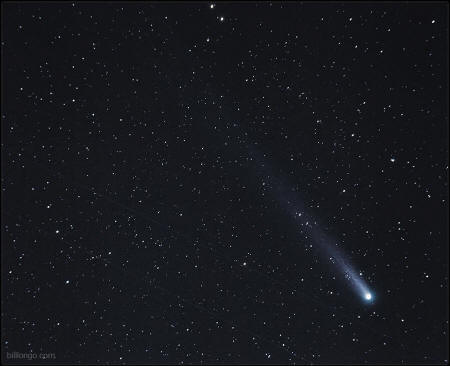|

by Nicole Mortillaro
December 13, 2013
from
GlobalNews Website

In this
combination of three images provided by NASA,
comet ISON appears as
a white smear heading up and away from the sun
on Thursday and
Friday, Nov. 28-29, 2013.
AP Photo/NASA
TORONTO
“Comet of the century!”
“To be seen in the daytime sky!”
These were only a few claims hyped by media upon the discovery of
Comet ISON in September 2012 by Russian astronomers Vitali Nevski
and Artyom Novichonok (a comet is usually named after its
discoverer, but this one was named after the project that discovered
it, the International Scientific Optical Network, ISON).
Of course,
none of those claims were true.
But
for scientists, it didn’t matter: ISON was a chance to peer back at
the very beginning of our solar system (read 'UPDATE
-
Comet ISON lives!').
Karl Battams, astrophysicist at the United States Naval
Research Laboratory (NRL)
in Washington, DC, and the voice of ISON throughout the comet’s
close pass, was happy with what was accomplished.
Battams led the
Comet ISON Observing Campaign.
Battams stressed that scientists never claimed ISON would put on the
show some believed would happen.
“Before us scientists even got to
put our word in, there were stories about the thing being
brighter than the full moon and ‘comet of the century,’ so that
made life difficult for us because what we… had to convey was
that this was a really, really exciting object, just not for the
reasons that you’ve been reading about.”
VIDEO: Comet ISON’s
pass around the sun (NASA)
And that reason was this: ISON was born out of
the Oort cloud - a
cloud that extends far beyond the orbit of Pluto - trillions of
kilometers away from the sun and which was born 4.5 billion years
ago.
And the fact that this comet was a sun-grazer
- a comet that
would pass very close to the sun - made it even more exciting.
Scientists would be able to see how this ancient piece of rock
interacted with solar radiation, learning about its composition and
characteristics.
This was ISON’s first pass, which meant that it had never been
bombarded by the sun’s radiation. Scientists wondered if the comet
would survive such a close pass - 1.2 million kilometers - above the
sun’s surface.
The sun is blazing hot at this distance, so hot that
it vaporizes almost everything.
“The very hardest rock you can imagine. If the comet was coated in
diamonds, the diamonds would instantly boil away and vaporize,”
Battams said.
All that heat and radiation was too much for the new comet.
Battam said that it may have been nicer to have had something in the
sky for people to see for themselves, but that doesn’t diminish how
important a role the comet played for scientists.
“We’ve gotten to watch this thing for such a long period of time
now, and we’ve recorded the largest and certainly the broadest data
set about a comet in history…
One of the key parts of studying a
comet is how were they put together. I think as any kid will tell
you, the best way to find out how a toy is put together is to rip it
apart,” Battams said, laughing.
“And as sad as it may seem, the sun ripped apart our little
Christmas present to see how it was put together, and that’s what
we’ve got to try to learn from.”
Astronomers will be analyzing the comet for months to come.
And they
have plenty of data to use.
“Scientifically, it’s just been absolutely incredible,” he said.
“I
think for me what I loved the most about this whole experience is
that we’ve pulled together not only professional observers from big
ground-based facilities, but we’ve got 13 different spacecraft
involved… Even stuff from Mars.
And to top it all off, the amateur
community has just been completely crucial to this whole process.
We’ve got an army of eyes around the world.”

Various NASA observing campaigns.
(NASA)
Though Hubble is scheduled to image where ISON should be, Battam
doubts that there will be anything to see.
Two other telescopes,
Chandra - an X-ray telescope - and
Spitzer - an infrared telescope - will also take a look.
It’s good to do this, Battam said, just to confirm that ISON is
indeed gone.
Though ISON may be gone, Battams pointed out that there’s still a
comet gracing our skies, Comet Lovejoy, that people can enjoy.

Comet ISON may be gone,
but Comet Lovejoy (C/2013 R1) is still
grazing the pre-dawn sky.
(Courtesy of Bill Longo)
The NRL has received many calls from people who bought telescopes in
the hope of catching ISON.
Now that it’s gone, they wonder if
there’s anything else to see.
“The sky is full of wonders. And the next bright comet is just
around the corner,” Battams said.

Where to find Comet Lovejoy
around 5 a.m. from a latitude of 43
degrees.
(Stellarium)
Next year will be chock-full of even more exciting comets.
There
will be
Comet C/2013 A1 (Siding Spring), which will pass incredibly
close to Mars at about 110,000 km above the planet’s surface (there
had been talk about it colliding with Mars, but calculations have
shown that this will not happen).
There is also the European Space
Agency’s
Rosetta mission which will release a lander on the
comet 67
P/Churyumov-Gerasimenko.
“And,” Battams said, “Who knows what will turn up in the meantime.”
Battams’s busy schedule is just settling down. He’s spent months
observing and analyzing ISON.
So, when asked what the next thing he’s excited about, Battams
laughed and said,
“A rest.”
Fire vs. Ice
The Science of ISON at Perihelion
December 10, 2013
from
NASA Website
After several days of continued observations, scientists continue to
work
to determine and understand the fate of Comet ISON:
There's no
doubt that the comet shrank in size considerably
as it rounded the
sun and there's no doubt that
something made it out on the other
side to shoot back into space.
Image Credit:
ESA/NASA/SOHO
After a year of observations, scientists waited with bated breath on
Nov. 28, 2013, as Comet ISON made its closest approach to the sun,
known as perihelion.
Would the comet disintegrate in the fierce heat
and gravity of the sun? Or survive intact to appear as a bright
comet in the pre-dawn sky?
Some remnant of ISON did indeed make it around the sun, but it
quickly dimmed and fizzled as seen with NASA's solar observatories.
This does not mean scientists were disappointed, however.
A
worldwide collaboration ensured that observatories around the globe
and in space, as well as keen amateur astronomers, gathered one of
the largest sets of comet observations of all time, which will
provide fodder for study for years to come.
On Dec. 10, 2013, researchers presented science results from the
comet's last days at the 2013 Fall American Geophysical Union
meeting in San Francisco, Calif.
They described how this unique
comet lost mass in advance of reaching perihelion and most likely
broke up during its closest approach, as well, as summarized what
this means for determining what the comet was made of.
"The comet's story begins with the very formation of the solar
system," said Karl Battams, an astrophysicist at the Naval Research
Lab in Washington, D.C.
"The dirty snowball that we came to call
Comet ISON was created at the same time as the planets."
ISON circled the solar system in the Oort cloud, more than 4.5
trillion miles away from the sun.
At some point a few million years
ago, something occurred – perhaps the passage of a nearby star – to
knock ISON out of its orbit and send it hurtling along a path for
its first trip into the inner solar system.
The comet was first spotted 585 million miles away in September 2012
by two Russian astronomers: Vitali Nevski and Artyom Novichonok. The
comet was named after the project that discovered it, the
International Scientific Optical Network, or ISON, and given an
official designation of C/2012 S1 (ISON).
When comet scientists
mapped out Comet ISON's orbit they learned that the comet would
swing within 1.1 million miles of the sun's surface, making it
what's known as a sungrazing comet, providing opportunities to study
this pristine bit of the early solar system as it lost material
while approaching the higher temperatures of the sun.
With this
knowledge, an international campaign to observe the comet was born.
The number of space-based, ground-based, and amateur observations
was unprecedented, including 12 NASA space-based assets observing
Comet ISON over the past year.
Near the beginning of October, 2013, two months before perihelion,
NASA's Mars Reconnaissance Observer, or MRO, turned its HiRISE
instrument to view the comet during its closest approach to Mars in
October 2013.
"The size of ISON's nucleus could be a little over half a mile
across - at the most. Very likely it could have been as small as
several hundred yards," said Alfred McEwen, the principal
investigator for the HiRISE instrument at Arizona State University,
in Tucson.
In other words, Comet ISON might have been the length of five or six
football fields. This small size was near the borderline of how big
ISON needed to be to survive its trip around the sun.
During that trip around the sun, Geraint Jones, a comet scientist at
University College London's Mullard Space Science Laboratory in the
UK studied the comet's dust tails to better understand what happened
as it rounded the sun.
By fitting models of the dust tail to the
actual observations from NASA's Solar Terrestrial Observatory, or
STEREO, and the joint European Space Agency/NASA Solar and Heliospheric Observatory, or SOHO, Jones showed that very little
dust was produced after perihelion, which may suggest that the
comet's nucleus had already broken up by that time.
A white plus sign shows where the Comet should have appeared in this
SDO image.

This image from NASA's Solar Dynamics Observatory
shows the sun, but no
Comet ISON was seen.
A white plus sign
shows where the Comet should have appeared.
Image Credit: NASA/SDO
While the comet was visible in STEREO and SOHO images going into
perihelion, it was not visible in the data from NASA's Solar
Dynamics Observatory, or SDO, or from ground based solar
observatories during its closest approach to the sun.
Dean Pesnell, project scientist
for SDO at NASA's Goddard Space Flight Center in Greenbelt, Md.,
explained why Comet ISON wasn't visible in SDO and what could be
learned from that:
SDO is tuned to see wavelengths of
light that would indicate the presence of oxygen, which is very
common in comets.
"The fact that ISON did not show
oxygen despite how close it came to the sun provides
information about how high was the evaporation temperature
of ISON's material," said Pesnell.
"This limits what it
could have been made of."
When Comet ISON was first spotted in
September 2012, it was relatively bright for a comet at such a great
distance from the sun.
Consequently, many people had high hopes
it would provide a beautiful light show visible in the night sky
throughout December 2013. That potential ended when Comet ISON
disrupted during perihelion.
However, the legacy of the comet will go
on for years as scientists analyze the tremendous data set collected
during ISON's journey.
|





